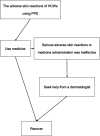The adverse skin reactions of health care workers using personal protective equipment for COVID-19
- PMID: 32541493
- PMCID: PMC7302613
- DOI: 10.1097/MD.0000000000020603
The adverse skin reactions of health care workers using personal protective equipment for COVID-19
Abstract
In December 2019, a new coronavirus was found in Wuhan, Hubei Province, China, and spread rapidly throughout the country, attracting global attention. On February 11, the World Health Organization (WHO) officially named the disease caused by 2019-nCoV coronavirus disease 2019 (COVID-19). With the increasing number of cases, health care workers (HCWs) from all over China volunteered to work in Hubei Province. Because of the strong infectivity of COVID-19, HCWs need to wear personal protective equipment (PPE), such as N95 masks, latex gloves, and protective clothing. Due to the long-term use of PPE, many adverse skin reactions may occur. Therefore, the purpose of this study is to explore the adverse skin reactions among HCWs using PPE.Questionnaires were used for the research; a quantitative study was carried out to determine the incidence of adverse skin reactions among HCWs using PPE.A total of 61 valid questionnaires were collected. The most common adverse skin reactions among HCWs wearing N95 masks were nasal bridge scarring (68.9%) and facial itching (27.9%). The most common adverse skin reactions among HCWs wearing latex gloves were dry skin (55.7%), itching (31.2%), and rash (23.0%). The most common adverse skin reactions among HCWs wearing protective clothing were dry skin (36.1%) and itching (34.4%).When most HCWs wear PPE for a long period of time, they will experience adverse skin reactions. The incidence of adverse skin reactions to the N95 mask was 95.1%, that to latex gloves was 88.5%, and that to protective clothing was 60.7%.
Conflict of interest statement
The authors have no conflicts of interest to disclose.
Figures
References
MeSH terms
LinkOut - more resources
Full Text Sources
Medical


